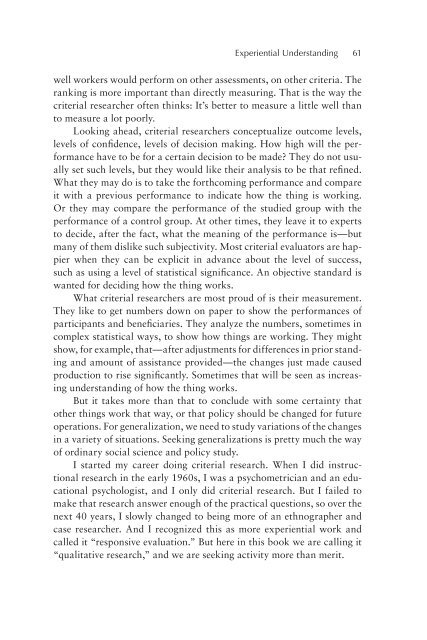How Things Work - Doha Academy of Tertiary Studies
How Things Work - Doha Academy of Tertiary Studies
How Things Work - Doha Academy of Tertiary Studies
Create successful ePaper yourself
Turn your PDF publications into a flip-book with our unique Google optimized e-Paper software.
experiential Understanding 61<br />
well workers would perform on other assessments, on other criteria. The<br />
ranking is more important than directly measuring. That is the way the<br />
criterial researcher <strong>of</strong>ten thinks: It’s better to measure a little well than<br />
to measure a lot poorly.<br />
Looking ahead, criterial researchers conceptualize outcome levels,<br />
levels <strong>of</strong> confidence, levels <strong>of</strong> decision making. <strong>How</strong> high will the performance<br />
have to be for a certain decision to be made? They do not usually<br />
set such levels, but they would like their analysis to be that refined.<br />
What they may do is to take the forthcoming performance and compare<br />
it with a previous performance to indicate how the thing is working.<br />
Or they may compare the performance <strong>of</strong> the studied group with the<br />
performance <strong>of</strong> a control group. At other times, they leave it to experts<br />
to decide, after the fact, what the meaning <strong>of</strong> the performance is—but<br />
many <strong>of</strong> them dislike such subjectivity. Most criterial evaluators are happier<br />
when they can be explicit in advance about the level <strong>of</strong> success,<br />
such as using a level <strong>of</strong> statistical significance. An objective standard is<br />
wanted for deciding how the thing works.<br />
What criterial researchers are most proud <strong>of</strong> is their measurement.<br />
They like to get numbers down on paper to show the performances <strong>of</strong><br />
participants and beneficiaries. They analyze the numbers, sometimes in<br />
complex statistical ways, to show how things are working. They might<br />
show, for example, that—after adjustments for differences in prior standing<br />
and amount <strong>of</strong> assistance provided—the changes just made caused<br />
production to rise significantly. Sometimes that will be seen as increasing<br />
understanding <strong>of</strong> how the thing works.<br />
But it takes more than that to conclude with some certainty that<br />
other things work that way, or that policy should be changed for future<br />
operations. For generalization, we need to study variations <strong>of</strong> the changes<br />
in a variety <strong>of</strong> situations. Seeking generalizations is pretty much the way<br />
<strong>of</strong> ordinary social science and policy study.<br />
I started my career doing criterial research. When I did instructional<br />
research in the early 1960s, I was a psychometrician and an educational<br />
psychologist, and I only did criterial research. But I failed to<br />
make that research answer enough <strong>of</strong> the practical questions, so over the<br />
next 40 years, I slowly changed to being more <strong>of</strong> an ethnographer and<br />
case researcher. And I recognized this as more experiential work and<br />
called it “responsive evaluation.” But here in this book we are calling it<br />
“qualitative research,” and we are seeking activity more than merit.

















